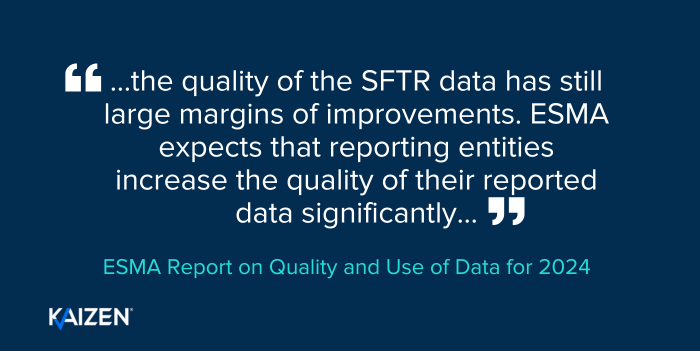ESMA’s Data Quality Report 2024: MiFiR transaction reporting remains a key focus

ESMA’s fifth report on data quality (published 30th April) – like last year’s – seemed light on a first read for MiFIR. But a second read alongside another ESMA document, the “Data Quality Engagement Framework (DQEF) for MiFIR’ published a week after the report, reminds us that MiFIR transaction reports and their data quality remain a key focus for ESMA and EU National Competent Authorities (NCAs).
The purpose of MiFIR transaction reporting
In the data quality report (DQR) ESMA reinforces, should we have forgotten, that data supports the day-to-day activities of financial regulators and remains essential for them to achieve their primary mandates of financial stability, orderly markets and market integrity.
“Reduce the reporting obligations on firms”
The DQR provides a number of use cases, introduces the DQEF and gives a significant mention to the role of transaction reports in the transparency and volume cap calculations that will reduce the reporting obligations on firms. In case you missed it – “reduce the reporting obligations on firms”. The proof of concept (PoC) to prove the role of reports in these calculations determined that data quality is good but the DQEF being introduced is designed to address the critical data quality issues that became apparent during the exercise.
Improved tooling for increased scrutiny
Furthermore, the DQR mentions that ESMA and NCAs now have improved tooling for monitoring markets. This includes details on the ESMA Data Platform (EDP) where regulators can share reported data and access predefined analytics to support them in their work. As we highlighted last year – firms contributing reports to these calculations that are lacking data quality can expect their NCA to give them an opportunity to discuss the issues found.
Delving into the details
At a macro level, reported data under MiFIR is used to monitor overall trends and key market-level developments. NCAs use the data in national financial stability reporting and sectoral updates whilst some have established systems to monitor trading venue activity or to rank firms based on their risk profiles.
For the detection of market abuse, NCAs have developed a variety of automated alerting tools to highlight behaviours that could threaten market integrity for follow up by surveillance staff. Data from different regimes is combined to identify cases of potential market abuse.
New tests to enhance data quality
The PoC to test the potential for using MiFIR data for transparency and volume cap calculations achieved > 95% accuracy and hence will replace the existing systems (FITRS and DVCAP) and reduce the reporting burden for firms. The discrepancies found will be addressed via the newly established DQEF based on ESMA’s existing transaction data validation rules and the TREM (Transaction Reporting Exchange Mechanism) DQEF tests, with new completeness, accuracy and consistency tests introduced to enhance data quality.
The aim is to launch the DQEF in the first half of 2025 to allow NCAs and firms to address the quality issues found – ahead of the go live of the new transparency and volume cap system.
Conclusion
We are often asked, ‘do regulators actually use the data?’ and the DQR provides clear evidence that they do. ESMA’s reuse of MiFIR transaction data for transparency and volume cap calculations demonstrates its commitment to reducing duplicative reporting – something the industry has long requested. However, increased data usage means increased scrutiny. Firms submitting poor quality data can expect to be contacted, remediation expected, warnings given and potential enforcement action.
Firms often approach us for quality assessments after the regulator has challenged their data. This puts them in damage control mode. The better approach is proactive quality assurance that identifies problems before regulators do. Please don’t hesitate to reach out to us at Kaizen to see how we can help.



